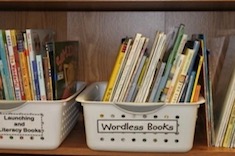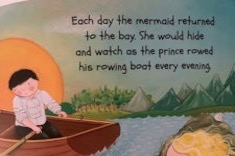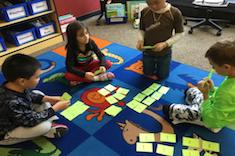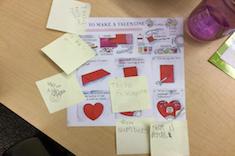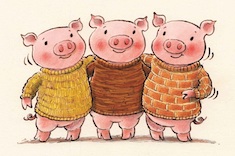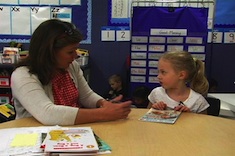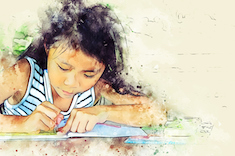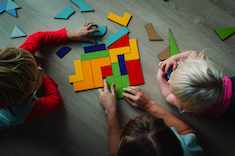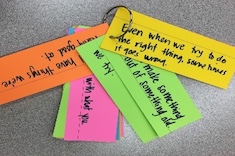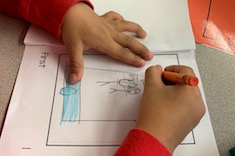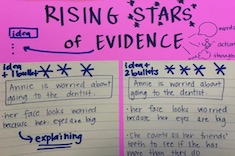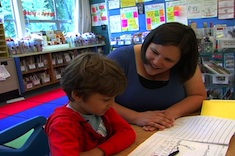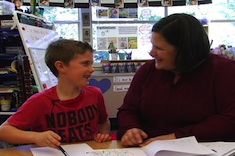1st
Latest Content
Book Selection for Early and Emergent Readers
Some emergent readers happily browse for books and explore them independently. For others, it’s a struggle. Cathy Mere shares her favorite strategies for helping all readers get comfortable with selecting books on their own.
The Good Part of Tech
Bitsy Parks shares how she integrates technology into her workshops with first graders in a way that is simple, effective, and natural.
First-Grade Guided Group: Reading Practice and Recap
Melissa Atwood leads a first-grade guided reading group. This is the second video in a two-part series.
Remembering the Big Picture in Reading Assessments
Kate Mills notes her own miscues in reading a bedtime story to her young children, and thinks about what that means for analyzing the running records of readers in primary classrooms.
First Graded Guided Group: Chunking Words
Melissa Atwood leads a first-grade guided reading group. The focus at the start of the lesson is on chunking words. This is the first video in a two-part series.
Quick and Easy Word Study Groups in First Grade
Bitsy Parks shares some of her favorite strategies for quick and meaningful word work groups in her first-grade classroom.
Reading Mats Build Confidence
Tammy Mulligan explains how the use of the popular “reading mats” can help build reader confidence.
A Quick How-to Writing Unit in First Grade
Bitsy Parks uses the short stretch before the holidays for a quick and fun how-to writing unit with her first graders.
When Learning Gets Tricky, Go Back to the Pigs
Whenever a tricky literary concept comes up, Tammy Mulligan finds herself returning to a favorite mentor text to guide students. She explains the value of shared simple stories for understanding complicated literary elements.
Conferring to Connect: First-Grade Reading
Bitsy Parks confers with first grader Ella about the Brown and Pearl book series, and then listens to Ella read. She closes the conference by encouraging Ella to make more personal connections to books.
Field Notes: Preserving Minilesson Time
Ruth Ayres shows how one first-grade teacher saves precious time by not ending minilessons with lots of directions for independent work.
First-Grade Read Alouds During Transitions
This brief video is an excerpt from a read aloud in a first-grade classroom during morning snack break. You’ll notice Bitsy Parks uses a projector so students can eat at tables and desks, and makes quick connections to other books.
Young Learners and Self-Talk
Do you have young readers and writers in your class who constantly talk to themselves? Stella Villalba helps a teacher decode the value of this self-talk for first grader Kayla, using it as a springboard for more learning.
No Pictures Stinks!
Shari Frost remembers how she inadvertently stifled the creativity of one of her most enthusiastic first-grade writers. Her story has important lessons for all of us about the importance of voice and choice for learners of all ages.
Student Greeting
Students in the first-grade classroom of Bitsy Parks lead a morning greeting at the start of the day. It’s a quick activity to check attendance, build reading skills, and help students learn the names of classmates in the community.
Managing Take-Home Books
Sending books home with young readers is essential. Cathy Mere gives lots of practical tips for designing a take-home books program and communicating with families about what young readers need.
Homework: I Challenge You!
Heather Fisher helps a first-grade teacher create a homework challenge as a way to make the practice more meaningful and engaging for students and families.
Growing Talk About Reading
Tara Barnett and Kate Mills find that struggling readers in the early grades benefit from scaffolds and repeated practice in small groups. They share some of their favorite tools, including key ring prompts and anchor charts.
Growing Toward Stories
Tara Barnett and Kate Mills use prompts and aids to help their youngest learners tell stories and find a writing voice.
Slowing Down
Bitsy Parks comforts a crying child after lunch, and realizes how essential it is to continually slow down the fast pace of learning in her classroom.
Secret Reader
Suzy Kaback marvels at a very young learner who is a “secret reader,” and this leads her to reassess the value of constantly celebrating new skills in school communities.
Stretching Writing in First Grade with Details
Bitsy Parks makes the home-school connection with first grader Grace early in the year as she writes about her birthday party.
Crafting the Basics: First-Grade Writing Conference
Bitsy Parks confers with Aubrey early in the year, using books from whole-class lessons as a scaffold for understanding key text elements like title, author, and illustrations.
Linking Evidence to Reading Response in First Grade
Tara Barnett and Kate Mills are discouraged by the random and idiosyncratic responses to reading they are seeing among first graders. They implement a series of lessons to help students move to evidence-based reading responses.
Clapping Syllables Routine in First Grade
Bitsy Parks works with her first graders early in the year to teach them the basics of how words are constructed, by clapping through syllable counts.
First-Grade Writing Conference: Celebrations to Suggestions
Katrina Edwards begins her conference with first grader Allen by celebrating all he is doing well in his writing. She highlights his language and details in writing before moving on to new strategies to try.
First-Grade Conference: Finding Seeds in Writing
Katrina Edwards confers with a first-grade writer and helps him unpack a narrative to use as seed writing.
Reading Minilesson: A Good Partner
Katrina Edwards helps her first graders early in the year transition to more thoughtful reading partnerships through a minilesson at the start of the morning workshop.
First-Grade Word Learning with Kinesthetics
Katrina Edwards teaches her first graders the word much using kinesthetics.
Moving Beyond Pokemon: Conferring with Clover
Bitsy Parks works with a first grader stuck on writing about Pokemon characters. She uses other writing from Clover to nudge her to try something new.
Browse Content By
Type
Category
- Assessment Tools
- Big Fresh Archives
- Booklists
- Choice Numeracy
- Classroom Design
- Common Core
- Community Building
- Conferring
- Content Literacy
- Digital Literacy
- English Language Learners
- Equity
- Family Relations
- Free Samples
- Guiding Groups
- Leadership
- Literacy Coaches
- Mentor Texts
- Minilessons
- New Teacher Mentors
- Podcasts
- Poetry
- Quote Collections
- Reading Strategies
- Self Care
- Struggling and Striving Learners
- Talking and Listening
- Teacher Study Groups
- Teaching Reading
- Teaching Writing
- Word Study and Vocabulary
Author
- Melissa Quimby
- Nawal Qarooni
- Gwen Blumberg
- Julie Cox
- The Lead Learners
- Hannah Tills
- Josie Stewart
- Ruth Metcalfe
- Mallory Messenger
- Becca Burk
- Jodie Bailey
- Vivian Chen
- Mary Brower
- Tiffany Abbott Fuller
- Stephanie Affinito
- Ruth Ayres
- Leigh Anne Eck
- Heather Fisher
- Shari Frost
- Julie Johnson
- Suzy Kaback
- Gigi McAllister
- Shirl McPhillips
- Melanie Meehan
- Cathy Mere
- Debbie Miller
- Tara Barnett and Kate Mills
- Tammy Mulligan
- Dana Murphy
- Bitsy Parks
- David Pittman
- Brenda Power
- Heather Rader
- Matt Renwick
- Mandy Robek
- Christy Rush-Levine
- Gretchen Schroeder
- Jen Schwanke
- Brian Sepe
- Katherine Sokolowski
- Stella Villalba
- Jennifer Vincent
Grade Level
Choice Literacy Membership
Articles
Get full access to all Choice Literacy article content
Videos
Get full access to all Choice Literacy video content
Courses
Access Choice Literacy course curriculum and training

